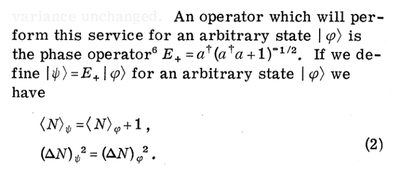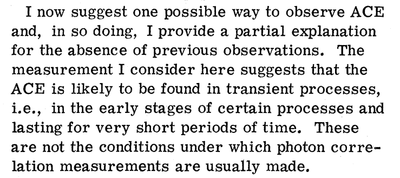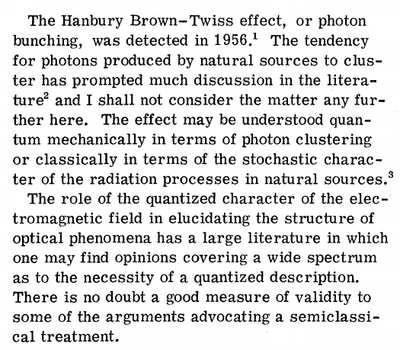Photon Antibunching and Possible Ways to Observe It. D. Stoler in Phys. Rev. Lett. 33:1397 (1974). What the paper says!?

This page is among our 'okay articles'. It should be further expanded but we hope that it will still be useful in its present stage.

This paper discusses antibunching, which at the time had not been observed and was not even clear how it could be produced. Stolers calls it the "negative Hanbury Brown-Twiss effect" and even more prominently, the ACE (anticorrelation effect). Surprisingly, he cites Fock states $\ket{n}$ as good candidates but say that they ««offer little hope of experimental realization»». He opens his discussion on an insightful approach: increasing the population of the state but not its variance. Since antibunching occurs when the variance is less than the mean, then iterated applications of this process will eventually produce antibunching. He refers for that to the phase operator:

He then proceeds to work out an actual case, though, interestingly, he arrives to a wrong conclusion that antibunching is to be found in transient processes:

He uses the degenerate parametric oscillator $a^{\dagger 2}$ which admits a simple analytic solution (his Eq. (3)), that he applies on the coherent state thereby admixing squeezing and coherent state, and finds some occurrence of antibunching in time as a result of this, but at a given time only and never to occur again. The details of this and how this connects to modern understanding, where there is no problem in having the process stationary, would be interesting to dive into. This is indeed a cute and quite deep result, with considerable historical importance.
He comes to the interesting conclusion that optimum squeezing does not appear to be crucial to antibunching. Given the particular case (time-dependent) he considers, and the confusion at the time of the nature of antibunching, this could be interpreted in a variety of ways:

The first two paragraphs are of great historical value:
